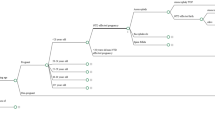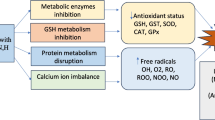Abstract
Purpose
The aim of this study is to elucidate the preventive effect of folic acid (FA) on teratogenic effects of valporic acid (VA) in early stage chick embryos on neural tube development.
Materials and methods
One hundred and fifty specific pathogen–free (SPF) chick eggs were used to investigate the neurulation in five groups. Group A was the control group. Group B was injected 0.02 ml of saline (0.9% NaCl) and was used for sham group. VA (0.72 mg) in 0.02 ml saline was injected in Group C, and 0.342 mcg of FA in 0.02 ml NaCl were administered to the embryos in Group D. VA (0.72 mg) + 0.342 mcg of FA in 0.02 ml saline were administered simultaneously to the eggs in Group E. At the end of 72 h, all embryos were extracted from eggs and were fixed, and for histological analyses hematoxylin and eosine was used, for detection of apoptotic cells terminal deoxyribonucleotide transferase-mediated dUTP-X nick end labeling (TUNEL) was used and for distribution of P53, bcl-2 and caspase-3, caspase-6, caspase-8 and caspase-9 immunoperoxidase techniques were used.
Results
While there were no neural tube defects in the embryos of groups A, B and D, eight embryos died in group C and there were 12 embryos with retarded embryological development. In contrast to that, no death was observed in group E, but only eight embryos were detected with maldevelopmental delay stage.
Conclusion
These results suggested that VA may induce apoptotic mechanisms but not through the p53 pathway. In addition, FA effectively prevents the teratogenic influence of VA on chick embryo at neurulation stages by stopping cascade of apoptosis before caspase 3 expression.



Similar content being viewed by others
References
Bupp Becker SR, Shibley IA (1998) Teratogenicity of ethanol in different chicken strains. Alcohol Alcohol 33(5):457–464
Cartwright MM, Smith SM (1995) Increased cell death and reduced neural crest cell numbers in ethanol exposed embryos partial basis for the fetal alcohol syndrome phenotype. Alcohol Clin Exp Res 19(2):378–386
Cartwright MM, Smith SM (1995) Stage dependent effects of ethanol on cranial neural crest cell development partial basis for the phenotypic variations observed in fetal alcohol syndrome. Alchol Clin Exp Res 19(6):1454–1462
Catala M, Teillet MA, De Robertis EM et al (1996) A spinal cord fate map in the avian embryo while regressing, Hensen's node lays down the notochord and floor plate thus joining the spinal cord lateral walls. Development 122:2599–2610
Colas JF, Schoenwolf GC (2001) Towards a cellular and molecular understanding of neurulation. Dev Dyn 221(2):117–145
Ernhart CB, Jokol RJ, Martier S, Moron P, Nadler D, Ager JW, Wolf A (1987) Alcohol teratogenicity in the human: a detailed assessment of specificity, critical period and threshold. Am J Obstet Gynecol 156(1):33–39
Eskes TKAB (2000) From anemia to spina bifida—the story of folic acid. A tribute to Professor Richard Smithells. Eur J Obstet Gynecol Reprod Biol 90(2):119–123
Gilani S, Persaud TV (1992) Embryonic development in the chick following exposure to ethanol, acetaldehyde and cyanamide. Ann Anat 174(4):305–308
Güney Ö, Selçuki M, Ünlü A, Bağdatoğlu C (1999) The effect of diazepam on the development of neural tube defects in early chick embryos. Turk Neurosurg 9:44–47
Güney Ö, Canbilen A, Konak A, Acar O (2003) The effects of folic acid in the prevention of neural tube development defects caused by phenytoin in early chick embryos. Spine 28(5):442–445
Hamburger V, Hamilton HL (1951) A series of normal stages in the development of the chick embryo. J Morph 88:49–92
Fagudes SBR (2008) Valproic acid review. Rev Neurosci 16(2):130–136
Kalter H (2000) Folic acid and human malformations: a summary and evaluation. Reprod Toxicol 14(5):463–476
Lee H, Nagele RG, Pietrolungo JF (1982) Toxic and teratologic effects of caffeine on explanted early chick embryos. Teratology 25(1):19–25
Lee HY, Keresztury MF, Kosciuk MC, Nagele RG, Roisen FJ (1984) Diazepam inhibits neurulation through its action on myosin-containing microfilaments in early chick embryos. Comp Biochem Physiol C 77(2):331–334
Lee H, Nagele RG (1985) Neural tube defects caused by local anesthetics in early chick embryos. Teratology 31(1):119–127
Lee H, Nagele RG (1986) Toxic and teratologic effects of verapamil on early chick embryos evidence for the involvement of calcium in neural tube closure. Teratology 33(2):203–211
Lee H, Bush KT, Nagele RG (1988) Time-lapse photographic study of neural tube closure defects caused by xylocaine in the chick. Teratology 37(3):263–269
Lindhout D, Omtzigt JGC, Cornel MC (1992) Spectrum of neural tube defects in 34 infants prenatally exposed to antiepileptic drugs. Neurology 42:111–118
Moore KL (2008) The developing human clinically oriented embryology 8th Ed , T V N Persaud, Saunders Elsevier
Nagele RG, Pietrolungo JF, Lee H, Roisen FJ (1981) Diazepam-induced neural tube closure defects in explanted early chick embryos. Teratology 23(3):343–349
New DAT (1955) A new technique for the cultivation of chick embryos in vitro. J Embryol Exp Morph 3:326–331
Selçuki M, Vatansever S, Umur AŞ, Temiz C, Sayın M (2008) Apoptosis seems to be the major process while surface and neural ectodermal layers detach during neurulation. Childs Nerv Syst 24(5):577–580
Unlu A (2002) Methods of developmental research. Acta Neurochir 83:71–78
Weil M, Jacobson MD, Raff MC (1997) Is programmed cell death required for neural tube closure? Curr Biol 7(4):281–284
Whitsel AI, Johnson CB, Forehand CJ (2002) An in ovo chicken model to study the systemic and localized teratogenic effects of valproic acid. Teratology 66(4):153–163
Vatansever HS, Umur AŞ, İnan VS, Selçuki M (2003) The effects of methotrexate on the development of neural tube defects in the chick embryo. Turk J Vet Anim Sci 27(5):1119–1125
Laurance KM, James N, Miller M, Tennat GB, Campbel H (1981) Double-blind randomised controlled trial of folate treatmant before conception to prevent recurrensce of neural tub defects. Br Med J 282:1509–1511
MRC vitamin study research group (1991) Prevention of neural tube defects: Results of the Medical Research Council Vitamin Study. Lancet 338:131–137
Werler MM, Shapiro S, Mchell AA (1993) Periconcepcional folic acid exposure and risk of occurrence neural tube defects. JAMA 269:1257–1261
Czeizel AE (1993) Prevention of congenital abnormalities by periconseptional multivitamin supplementation. BMJ 306:1645–1648
Parnham MJ, Bruinvels J (1999) Valproate. Birkhauser Verlag, Germany, pp 1–3
Ziauddin MF, Yeow WS, Maxhaimer JB, Baras A, ChuaA RRM, Cole GW Jr, Schrump DS, Nguyen DM (2006) Valproik asit an antiepileptic drug with histone deasetylase inhibitory activity, potentiates the cytotoxic effect of apo2L/TRAIL on cultured thoracic cancer cells through mitochonria-depent caspase activation. Neoplasia 8:446–457
Cornel MC, Erickson JD (1997) Comparison of national policies on periconceptional use of folic acid to prevent spina bifida and anencephaly. Teratology 55:134–137
Acknowledgments
This investigation was presented at the annual meeting of International Society for Pediatric Neurosurgery, Jeju/Korea, 2010.
Conflict of interest
The authors do not have conflict of interest either with chemical used for the investigation or with the companies that produce the chemical used.
Author information
Authors and Affiliations
Corresponding author
Rights and permissions
About this article
Cite this article
Umur, A.S., Selcuki, M., Bursali, A. et al. Simultaneous folate intake may prevent advers effect of valproic acid on neurulating nervous system. Childs Nerv Syst 28, 729–737 (2012). https://doi.org/10.1007/s00381-011-1673-9
Received:
Accepted:
Published:
Issue Date:
DOI: https://doi.org/10.1007/s00381-011-1673-9




